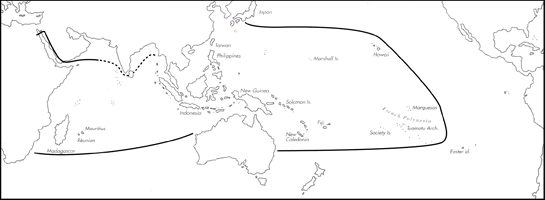
Skip Navigation Links
View access keys for this site.

Range: Southern Natal to Red Sea and to Hawaii and French Polynesia; no reports from the Arabian Sea and India.
Description: Moderately large to large, solid to heavy. Last whorl conical; outline convex to strongly convex near shoulder, straight below. Shoulder variably angulate, tuberculate in smaller adults (up to 75-85 mm in length). Spire of low to moderate height, outline concave to convex. Postnuclear spire whorls tuberculate. Teleoconch sutural ramps concave, with 2-3 faint spiral grooves in middle ramps, and finer spiral striation on later ramps. In subadults, last whorl with broad spiral ribs at base, followed by about 5 widely set spiral grooves almost to adapical third with ribbons between. In large adults, surface smooth except for broad but faint spiral ribs at base.
| Shell Morphometry | ||
|---|---|---|
| L | 65-137 mm | |
| RW | 0.60-2.00 g/mm | |
| RD | 0.54-0.64 | |
| PMD | 0.85-0.95 | |
| RSH | 0.04-0.18 | |
Ground colour white. In smaller subadults (pl. 2, fig. 19), last whorl with olive brown clouds, base dark brown. During growth, clouded pattern changing to a band on each side of centre; bands either progressively occupying entire last whorl (Pacific populations) or secondarily reduced (Indian Ocean populations). Bands usually become less olive and base slightly lighter during growth. Teleoconch spire with blackish brown radial markings between tubercles (including large Indian Ocean shells without colour bands on last whorl). Periostracum blackish brown, thick, opaque, and rough in large adults from Philippines (L 130 mm) and lighter brown, thinner, with widely set spiral rows of strong tufts on last whorl and spire in subadults from Madagascar. A thick, olive-green or brown periostracum with tufted ridges around last whorl is reported from Hawaii (Kohn, 1959a) and Fiji (Cernohorsky, 1964).
Dorsum of foot with orange-brown marginal zone, except for anterior end; a line of blackish brown spots setting off marginal zone from pale orange median and anterior areas, with tan spots centrally and dark brown spots anteriorly. Foot often largely brown (Hawaii). Rostrum whitish tan (N. Papua New Guinea) to dark brown (Hawaii); tipped with yellow in Hawaii. Tentacles light brown (Hawaii) to greyish white with white tip (N. Papua New Guinea). Siphon light tan mottled with brown (Hawaii) or white, mottledwith orange and brown except tip (N. Papua New Guinea) (Kohn, 1959a; Chaberman, pers. comm., 1981) (Pl. 74, fig. 2).
Radular teeth relatively small and stout, with a fold near apex and an adapical barb opposite a blade; neither serration nor basal spur present (Peile, 1939; James, 1980). Nybakken (1990) described the teeth as similar to those of predators of amphinomids polychaetes (e.g. C. zonatus, C. imperialis).
Habitat and Habits: Intertidal and upper subtidal; juveniles in greater depths. In Hawaii, C. distans inhabits intertidal benches and subtidal coral reef platforms, more frequently in the latter habitat, where it occurs epifaunally in outer areas exposed to surf action (Kohn, 1959b; Kay, 1979). In Fiji, it lives on patches of sand among weed (Cernohorsky, 1964). Tirard (pers. comm., 1989) reports C. distans from New Caledonia to live in 2-6 m on coral reef and to be active during the whole day. In East New Britain, it occurs subtidally under rocks, wedged inside holes and crevices of the deeper reef and boulders, or on the shallow reef, where it is covered by epiflora (Richards, pers. comm., 1989). It occurs on subtidal reef flats in Indonesia and Thailand (Kohn & Nybakken, 1975), and is more frequent on intertidal benches than subtidal reefs in the Maldive and Chagos Archipelagoes (Kohn, 1968). In Mocambique, it lives on outer areas of reef platforms (Grosch, pers. comm., 1989). C. distans feeds on polychaetes (Eunicidae) in Hawaii (Kohn, 1959a). However, armature of radular teeth differs from that of congeners with a similar diet (Nybakken, 1990). Egg capsules large, containing numerous eggs. Egg diameter of about 148 µm in Palau suggests a minimum pelagic period of about 28 days (Perron & Kohn, 1985; Loch, pers. comm., 1987).
Discussion: The shells of C. distans are quite distinctive and are unlikely to be confused with those of any of its congeners.

C. distans Range Map
This section contains verbatim reproductions of the accounts of 316 species of Conus from the Indo-Pacific region, from Manual of the Living Conidae, by Röckel, Korn and Kohn (1995). They are reproduced with the kind permission of the present publisher, Conchbooks.
All plates and figures referred to in the text are also in Röckel, Korn & Kohn, 1995. Manual of the Living Conidae Vol. 1: Indo-Pacific Region.
The range maps have been modified so that each species account has it own map, rather than one map that showed the ranges of several species in the original work. This was necessary because each species account is on a separate page on the website and not confined to the order of accounts in the book.
Return to framed version (returns to search page)